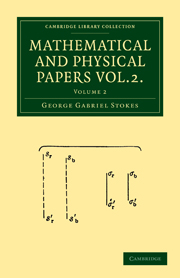Book contents
- Frontmatter
- Contents
- Notes on Hydrodynamics. III. On the Dynamical Equations
- On the constitution of the Luminiferous Ether
- On the Theory of certain Bands seen in the Spectrum
- Notes on Hydrodynamics. IV. Demonstration of a Fundamental Theorem
- On a difficulty in the Theory of Sound
- On the Formation of the Central Spot of Newton's Rings beyond the Critical Angle
- On some points in the Received Theory of Sound
- On the perfect Blackness of the Central Spot in Newton's Rings, and on the Verification of Fresnel's Formula for the intensities of Reflected and Reflacted Rays
- On Attractions, and on Clairaut's Theorem
- On the Variation of Gravity at the Surface of the Earth
- On a Mode of Measuring the Astigmatism of a Defective Eye
- On the Determination of the Wave Length corresponding with any Point of the Spectrum
- Discussion of a Differential Equation relating to the Breaking of Railway Bridges
- Notes on Hydrodynamics, VI. On Waves
- On the Dynamical Theory of Diffraction
- On the Numerical Calculation of a class of Definite Integrals and Infinite Series
- On the Mode of Disappearance of Newton's Rings in passing the Angle of Total Internal Reflection
- On Metallic Reflection
- On a Fictitious Displacement of Fringes of Interference
- On Haidinger's Brushes
- Index
Notes on Hydrodynamics. IV. Demonstration of a Fundamental Theorem
Published online by Cambridge University Press: 07 September 2010
- Frontmatter
- Contents
- Notes on Hydrodynamics. III. On the Dynamical Equations
- On the constitution of the Luminiferous Ether
- On the Theory of certain Bands seen in the Spectrum
- Notes on Hydrodynamics. IV. Demonstration of a Fundamental Theorem
- On a difficulty in the Theory of Sound
- On the Formation of the Central Spot of Newton's Rings beyond the Critical Angle
- On some points in the Received Theory of Sound
- On the perfect Blackness of the Central Spot in Newton's Rings, and on the Verification of Fresnel's Formula for the intensities of Reflected and Reflacted Rays
- On Attractions, and on Clairaut's Theorem
- On the Variation of Gravity at the Surface of the Earth
- On a Mode of Measuring the Astigmatism of a Defective Eye
- On the Determination of the Wave Length corresponding with any Point of the Spectrum
- Discussion of a Differential Equation relating to the Breaking of Railway Bridges
- Notes on Hydrodynamics, VI. On Waves
- On the Dynamical Theory of Diffraction
- On the Numerical Calculation of a class of Definite Integrals and Infinite Series
- On the Mode of Disappearance of Newton's Rings in passing the Angle of Total Internal Reflection
- On Metallic Reflection
- On a Fictitious Displacement of Fringes of Interference
- On Haidinger's Brushes
- Index
Summary
Theorem. Let the accelerating forces X, Y, Z, acting on the fluid, be such that Xdx + Ydy + Zdz is the exact differential d V of a function of the coordinates. The function V may also contain the time t explicitly, but the differential is taken on the supposition that t is constant. Suppose the fluid to be either homogeneous and incompressible, or homogeneous and elastic, and of the same temperature throughout, except in so far as the temperature is altered by sudden condensation or rarefaction, so that the pressure is a function of the density. Then if, either for the whole fluid mass, or for a certain portion of it, the motion is at one instant such that udx + vdy + wdz is an exact differential, that expression will always remain an exact differential, in the first case throughout the whole mass, in the second case throughout the portion considered, a portion which will in general continually change its position in space as the motion goes on. In particular, the proposition is true when the motion begins from rest.
Two demonstrations of this important theorem will here be given. The first is taken from a memoir by M. Cauchy, “ Mémoire sur la Théorie des Ondes, &c. ” (Mém. des Savans Strangers, Tom. i. (1827), p. 40). M.
Information
- Type
- Chapter
- Information
- Mathematical and Physical Papers , pp. 36 - 50Publisher: Cambridge University PressPrint publication year: 2009First published in: 1883
Accessibility standard: Unknown
Why this information is here
This section outlines the accessibility features of this content - including support for screen readers, full keyboard navigation and high-contrast display options. This may not be relevant for you.Accessibility Information
- 1
- Cited by
